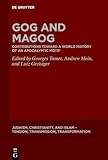Gog and Magog : Contributions toward a World History of an Apocalyptic Motif / ed. by Lutz Greisiger, Andrew Mein, Georges Tamer.
Material type: TextSeries: Judaism, Christianity, and Islam – Tension, Transmission, Transformation ; 17Publisher: Berlin ; Boston : De Gruyter, [2023]Copyright date: ©2024Description: 1 online resource (XX, 1071 p.)Content type:
TextSeries: Judaism, Christianity, and Islam – Tension, Transmission, Transformation ; 17Publisher: Berlin ; Boston : De Gruyter, [2023]Copyright date: ©2024Description: 1 online resource (XX, 1071 p.)Content type: - 9783110720150
- 9783110720242
- 9783110720235
- online - DeGruyter
- Issued also in print.
| Item type | Current library | Call number | URL | Status | Notes | Barcode | |
|---|---|---|---|---|---|---|---|
 eBook
eBook
|
Biblioteca "Angelicum" Pont. Univ. S.Tommaso d'Aquino Nuvola online | online - DeGruyter (Browse shelf(Opens below)) | Online access | Not for loan (Accesso limitato) | Accesso per gli utenti autorizzati / Access for authorized users | (dgr)9783110720235 |
Frontmatter -- Acknowledgments -- Contents -- Volume 1 -- Introduction: Gog and Magog and their Worlds -- Beyond the Wall: Eurasian Steppe Nomads in the Gog and Magog Motif -- “Impenetrable, Physical, Tall, Powerful, Beautiful?” Comparative Considerations on the Imperial Border Walls of the Ancient World (Sumer, Egypt, Assyria, China, Rome, Iran) -- Gog from Magog: A Supporting Actor in the End Time Restitution -- Gog and Magog in Syriac Literature I: Literature Unconnected to the Alexander Legend Prior to Michael the Syrian -- The Reception of Gog and Magog in Jewish Traditions at the Emergence of Islam -- Gog and Magog in Syriac Literature II: Literature Connected to the Alexander Legend Prior to Michael the Syrian -- Gog and Magog between Exegesis and Prophecy in the Eighth and Ninth Centuries CE -- Gog & Magog in Byzantium – A Pessimistic Story -- The Enclosed Nations of Mandæan Lore -- Gog and Magog in Islam: A Permanent Geographic Problem -- Gog and Magog in Syriac Literature III: Literature from Michael the Syrian to the Modern Era -- Hide and Seek with a Monster: Gog and Other Antichrists in Joachim of Fiore’s Eschatology -- Gog et Magog nondum sunt in orbe nec umquam fuerunt. – John of Rupescissa, the Hardened Dregs of the Next Antichrist and Christian Self-Criticism -- The Formation of the Gog/Magog-Concept and Its Use in Medieval Latin Historiography (until 1200) -- Het ez sant Peter getan, / Ez wer wünders mehr dann vil. Alexander, Gog und Magog in der (deutschen) Literatur des Mittelalters -- Von Riesen und Rittern zum islamischen Feind. Gog und Magog in der mittelalterlichen Apokalypse-Illustration -- Gog and Magog as Geographical Realities in Late Medieval Latin Europe -- Gog and Magog or Allies? The Perception of the Ottoman Empire in Martin Luther and Thomas Müntzer -- Alexander and Gog and Magog in Ottoman Illustrated Texts: Presenting the Pādişāh as the End-Times’ World Sovereign in an Age of Eschatological Enthusiasm -- From Turk to Tyrant: Gog in Seventeenth-Century English Ezekiel Commentary -- Volume 2 -- Gog and Magog in Malay-Indonesian Islamic Exegetical Works -- Yaʾjūj and Maʾjūj in the Báb’s Qayyūm al-Asmāʾ -- Towards a Comparative and Literary Anthropology of Force and Chaos: Gog and Magog with Particular Reference to Kitāb al-Fitan by Nuʿaym b. Ḥammād al-Marwazī (d.229/844) and The Tower of London by William Harrison Ainsworth (1805–1882) -- Gog and Magog in Hasidism: Actualizing, Spiritualizing, and Marginalizing the Evil that Precedes Redemption -- “The Climate Will Change Again and Yeʾcüc and Meʾcüc Will Leave Their Places”: Gog and Magog in Two Late Ottoman Texts -- “I Am the Son of Gog and Magog.” Assuming the Role of Destroyer and Renovator in a Programmatic Poem by Endre Ady (1906) -- Asian Horsemen, Bolshevik Monsters. Europe’s Primal Fear of the East -- The Enemy within: A Structural Approach to the Transmission of the Motif of Gog and Magog into the Modern Dialectics of Internationalization and Nationalization -- Outside, Over There: Buber’s Gog and Magog and Why He Told Stories about Evil -- The Faces of Gog and Magog in Islam -- Awaiting the Battle of Gog and Magog: Christians, Jews, and the Yearning for Apocalyptic Times -- Gog and Magog in Muslim Teleological Eschatology: Traditional Islamic Narrations and Modern Islamist Politicizations -- Narrative Subordination: Comparative Approaches to Gog and Magog as Literary Figures -- GOG/MAGOG. A Disinformation Campaign -- “Russia is a Gog”: Scenes from a German Tradition -- Bibliography -- Index -- List of Contributors
restricted access online access with authorization star
http://purl.org/coar/access_right/c_16ec
The tale of a collective evil force known as Gog and Magog has occupied the imagination of Jews, Christians, and Muslims for millennia, finding expression in literary and scholarly works and other cultural artifacts. This book gathers the papers from two conferences at the University of Erlangen-Nuremberg by scholars ranging from history, to religious studies, to art history, and is the most thorough work on the subject to date.
Issued also in print.
Mode of access: Internet via World Wide Web.
In English.
Description based on online resource; title from PDF title page (publisher's Web site, viewed 06. Mrz 2024)


